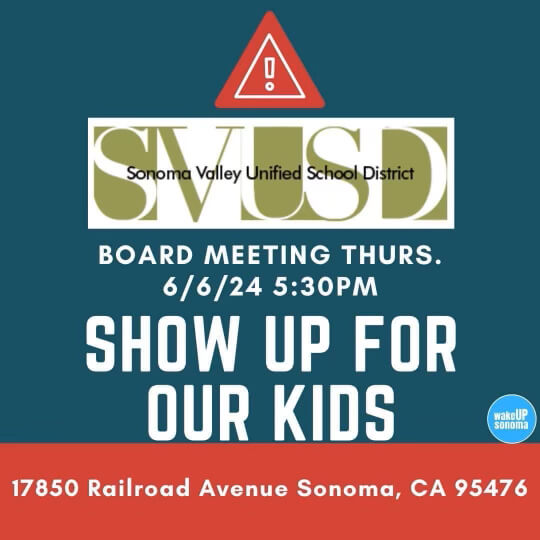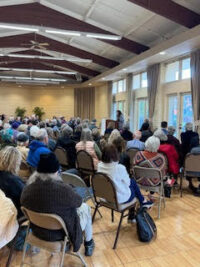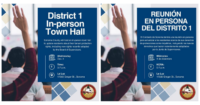At its Board Meeting on June 6, 2024, the Sonoma Valley Unified School District will discuss its regulations pertaining to gender identity and equal access for students. The complete text of the adopted regulations is shown below.
Administrative Regulation 5157 Gender Identity and Access
PURPOSE
The purpose of this Administrative Regulation is to advise SCCOE staff regarding issues relating to transgender, non-binary and gender expansive students in order to create and maintain a safe learning environment for all students and to ensure that every student has equal access to the SCCOE’s educational programs and activities.
This regulation sets out guidelines for school and SCCOE staff to address the needs of transgender, non-binary, and gender expansive students and explains how these nondiscrimination laws should be implemented in situations where questions may arise about how to protect the legal rights or safety of students. This regulation does not anticipate every situation that might occur with respect to transgender, non-binary, and gender expansive students, and the needs of each student must be assessed on a case-by-case basis. In all cases, the goal is to ensure the safety, comfort, and healthy development of all students, including transgender, non-binary, and gender expansive students, maximizing inclusion and social integration while minimizing exclusion and stigmatization.
DEFINITIONS
These definitions are not meant to label any student but are intended as functional descriptors. Students may or may not use these terms to describe themselves. Transgender, non-binary, and gender expansive youth may use different words to describe their lives and experiences of gender. Terminology and language can differ based on region, language, race or ethnicity, age, culture, and many other factors. School staff and educators should use the terms that students request be used to describe themselves and avoid terms that make these students uncomfortable.
- Gender: Socially determined characteristics, roles, behaviors, and attributes a society expects from and considers appropriate for males and females; these characteristics are often referred to as “feminine” and “masculine.” Under California law, “gender” is defined to include a person’s gender identity. (Cal. Ed. Code § 210.7)
- Gender Fluid: Persons who do not identify as, or who do not express themselves as, solely male or female.
- Gender Expression: The manner in which a person represents or expresses gender to others, often through behavior, clothing, hairstyles, activities, voice, or mannerisms.
- Gender Identity: A person’s internal, deeply-rooted knowledge of their own gender, which can include being female, male, another gender, or no gender. Gender identity is an innate and largely inflexible part of a person’s identity. One’s gender identity can be the same or different than the gender assigned at birth. The responsibility for determining an individual’s gender identity rests with the individual.
- Gender Expansive: Displaying gender traits that are not consistent with stereotypical characteristics associated with one’s sex assigned at birth, or others’ perceptions of that sex. This term can be used to describe people whose gender expression differs from stereotypical expectations about how boys and girls are “supposed to” look or act.
- Nonbinary/Queer/Genderqueer: These are terms often used to describe people whose gender is not exclusively male or female, including those who identify with a gender other than male or female, as more than one gender, or as no gender.
- LGBTQ: An umbrella term that stands for “lesbian, gay, bisexual, transgender, and questioning.”
- Sexual Orientation: A person’s romantic, emotional, sexual attraction to people of the same gender, another gender, or other genders . (Cal. Ed. Code § 212.6) Common terms used to describe sexual orientation include, but are not limited to heterosexual, lesbian, gay, and bisexual. Sexual orientation and gender identity are different. Transgender students may identify as gay, lesbian, bisexual, or heterosexual, among other sexual orientations. Sexual bullying is any behavior which degrades someone, singles someone out by the use of sexual language, gestures or violence, and victimizing someone for their appearance. Sexual
bullying is also pressure to act promiscuously and to act in a way that makes others uncomfortable. Non-consensually outing a student, mis-gendering, and deadnaming are also types of sexual bullying. Deadnaming is the use of the birth or other former name (i.e., a name that is “dead”) of a transgender or non-binary person without the person’s consent.[1] Deadnaming may be accidental; however, it may also be used to intentionally dismiss, deny or reject a person’s gender identity. - Transgender: An umbrella term for people whose gender identity differs from the sex they were assigned at birth. People under the transgender umbrella may describe themselves using one or more of a wide variety of terms – including transgender. Some of those terms are defined below. Use the descriptive term preferred by the person. Many transgender people are prescribed hormones by their doctors to bring their bodies into alignment with their gender identity. Some undergo surgery as well. But not all transgender people can or will take those steps, and a transgender identity is not dependent upon physical appearance or medical procedures.
- Transitioning: The process in which a person begins to live according to their gender identity, rather than the gender they were thought to be at birth. Transition is a process that is different for everyone, and it may or may not involve social, legal, or physical changes. There is no one step or set of steps that an individual must undergo in order to have their gender identity affirmed and respected.
PRIVACY
All persons, including students, have a right to privacy: the right to decide when, with whom, and how much highly personal information one wants to share about oneself to others. This includes the right to control dissemination of highly personal and private information such as one’s transgender status or sexual orientation.
The SCCOE shall ensure that all personally identifiable and medical information relating to transgender and gender nonconforming students shall be kept confidential in accordance with applicable state, local, and federal privacy laws. SCCOE and school personnel shall not disclose a student’s transgender status to others, including, but not limited to, other students, parents, and/or other school personnel. In the rare instance that a school is legally required to disclose a student’s transgender status, the school should provide the student an opportunity to make that disclosure themselves, where practicable. This includes, but is not limited to, providing the student with any support services the student would need to make the disclosure in a safe and supportive environment.
The fact that a student chooses to use a different name, to transition at school, or to disclose their transgender status to staff or other students does not authorize school staff to disclose a student’s personally identifiable or medical information. Before contacting the parent or guardian of a transgender student, school staff should ask the student whether to use their chosen name and the pronouns that correspond to their gender identity, or whether to use their legal name.
The right of students to keep their gender status private is grounded in California’s antidiscrimination laws as well as federal and state laws. Disclosing that a student is transgender without the student’s permission may violate California’s antidiscrimination law by increasing the student’s vulnerability to harassment and may violate the student’s right to privacy.
Schools are not permitted to disclose private student information to other students or the parents of those students.
A transgender student’s right to privacy does not restrict a student’s right to openly discuss and express their gender identity or to decide when or with whom to share private information. A student does not waive their right to privacy by selectively sharing this information with others.
NAMES, PRONOUNS, and SCHOOL RECORDS
The responsibility for determining a student’s gender identity rests with the student or, in the case of young students not yet able to advocate for themselves, with the parent or guardian.
A school should accept a student’s asserted gender identity. Students have the right to be addressed by a name and pronouns that correspond to their gender identity. Regardless of whether a transgender or gender nonconforming student has legally changed their name or gender, schools shall allow students to use a chosen name and gender pronouns that reflect their identity. It is recommended that school staff privately ask transgender or gender nonconforming students how they want to be addressed in class and in the school’s communication with the student’s parents or guardians.
If a student has previously been known at school by a different name, the school administration will direct school personnel to use the student’s chosen name and appropriate pronouns. To ensure consistency among administrators and staff, every effort shall be made to immediately update student education records (such as attendance reports, class rosters for substitutes, school IDs, transcripts, electronic records, etc.) with the student’s chosen name and appropriate gender markers.
In some circumstances, school administrators may be specifically required by law to record a student’s name or gender as it appears on documents such a current birth certificate. In those instances, school staff and administrators shall record this information in a separate, confidential file to avoid the inadvertent disclosure of the information. All records that are not specifically required by law to match government-issued documents shall be updated upon a student’s request. Similarly, a student is not required to have obtained a court-ordered name
or gender marker change in order to have their requested name and gender identity recognized and respected by a school.
The SCCOE is required to maintain an official, permanent pupil record with the legal name and gender appearing on the student’s birth certificate. On all other school- related records or documents, however, at the request of or with the consent of the student’s parent/legal guardian (unless the student is over 18), schools should use a transgender student’s requested name and gender pronoun. This would include physical records and documents, diplomas and other certificates of advancement, electronic records and documents, and school IDs. Every effort should be made to update student records with the student’s requested name and gender pronoun or gender marker, and not to circulate records with the student’s assigned birth name or gender marker. Schools should also identify routine areas where a transgender student’s privacy could be violated by the improper usage of the legal name and gender marker.
These include but are not limited to pre-printed labels, standardized tests, student IDs or library cards, lunch tickets, school photos, notices from the main office, attendance slips, grade books, posted lists of student names, lesson plans, seating charts and roll sheets used by substitute teachers, and any other places where students’ names are commonly written.
In order to protect the student’s privacy, and to prevent accidental disclosure of a student’s transgender status, the school should maintain the official, permanent pupil record in a secure location, separate from the student’s other records. If the official record is maintained electronically, similar security measures should be implemented to protect student privacy.
In the event that a student identifies as transgender, but is unable to obtain consent from a parent or legal guardian, a school administrator should meet with the student to discuss how the student would like to be addressed at school and implement a plan to ensure that the student’s privacy is protected.
When a student or parent/legal guardian presents the school with documentation of a court ordered legal name and/or gender change, the school must then change the official, permanent pupil record, to reflect the student’s new legal name and gender, in a timely manner.
Transgender students who transition after having graduated may ask their previous schools to amend school records or a diploma or transcript that include the student’s birth name and gender. When requested, schools should amend the student’s record, including reissuing a high school diploma or transcript, to reflect the student’s current name and gender.
ACCESS TO GENDER-SEGREGATED FACILITIES AND ACTIVITIES
Restrooms/Locker Rooms:
Schools may maintain separate restroom facilities for male and female students. However, the choice shall be determined by the student.
Where available, a single stall, “gender neutral” restroom (such as in the health office) may be used by any student who desires increased privacy, regardless of the underlying reason. The use of such a “gender neutral” restroom shall be a matter of choice for a student and no student shall be compelled to use such a restroom. Schools are required to ensure single stall bathrooms be identified as all-gender toilet facilities.
Locker rooms:
Schools may maintain separate locker room facilities for male and female students. However, the locker room facility choice shall be made by the student. . If any student has a need or desire for increased privacy or safety, regardless of the underlying reason, they may be provided access to a reasonable alternative changing area or locker room such as:
- Use of a private area in the public area of the locker room facility (i.e., a nearby restroom stall with a door, an area separated by a curtain, or aP.E. instructor’s office in the lockerroom).
- A separate changing schedule (either utilizing the locker room before or after other students).
- Use of a nearby private area (i.e., a nearby restroom or a health office restroom).
As a proactive measure, administrators should take steps to identify private gender-neutral options on their campus, as well as to de-stigmatize the use of such private options. Establishing clear guidelines and expectations with regards to students’ physical privacy and boundaries is also important. Both can be reinforced through language in student handbooks, posted expectations, and through orientation and other processes for familiarizing students and guardians to the school and its facilities.
Physical Education Classes and Intramural and Interscholastic Athletics:
All students shall be permitted to participate in physical education classes and intramural sports in a manner consistent with their gender identity. Furthermore, all students shall be permitted to participate in interscholastic athletics in a manner consistent with their gender identity, under the guidelines established by the state interscholastic association. This is consistent with California and federal law as well as the policies established by the California Interscholastic Federation. (CIF Bylaws §300(D)).
DRESS CODES/SCHOOL UNIFORM POLICIES
Schools may enforce dress codes pursuant to SCCOE policy, but any such dress codes may not be enforced based on gender or gender stereotypes. All students have the right to dress in accordance with their gender identity and gender expression including maintaining a genderneutral appearance within the constraints of the dress codes adopted by the school. School dress code and uniform policies should be gender-neutral and should not restrict students’ clothing choices on the basis of gender or traditional stereotypes about what males and females “should” wear. School staff shall not enforce a school’s dress code more strictly against transgender and gender nonconforming students than other students.
HARASSMENT AND BULLYING
Complaints alleging discrimination, harassment or bullying based on a student’s gender identity, gender expression, or gender nonconformity, are to be handled in the same manner as other discrimination/harassment/bullying complaints. Consistent with the Uniform Complaint Procedures, complaints alleging discrimination or harassment based on a student’s gender identity, gender expression, or gender nonconformity should be given immediate attention; fully and appropriately investigated in a timely manner; and resolved through appropriate corrective action.
Adopted: May 2, 2017
Revised: June 8, 2021








Be First to Comment